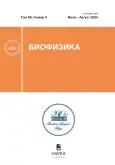Innovative Biophysical Approaches for Quercetin Extraction from Plant Cells
- 作者: Pogorelov A.G1, Ipatova L.G1, Panait A.I1, Stankevich A.A1, Yunusova A.K1, Pogorelova V.N1
-
隶属关系:
- Institute of Theoretical and Experimental Biophysics, Russian Academy of Sciences
- 期: 卷 69, 编号 4 (2024)
- 页面: 715-722
- 栏目: Molecular biophysics
- URL: https://journals.rcsi.science/0006-3029/article/view/264937
- DOI: https://doi.org/10.31857/S0006302924040049
- EDN: https://elibrary.ru/NHYWDY
- ID: 264937
如何引用文章
全文:
详细
作者简介
A. Pogorelov
Institute of Theoretical and Experimental Biophysics, Russian Academy of Sciences
Email: agpogorelov@rambler.ru
Pushchino, Russia
L. Ipatova
Institute of Theoretical and Experimental Biophysics, Russian Academy of SciencesPushchino, Russia
A. Panait
Institute of Theoretical and Experimental Biophysics, Russian Academy of SciencesPushchino, Russia
A. Stankevich
Institute of Theoretical and Experimental Biophysics, Russian Academy of SciencesPushchino, Russia
A. Yunusova
Institute of Theoretical and Experimental Biophysics, Russian Academy of SciencesPushchino, Russia
V. Pogorelova
Institute of Theoretical and Experimental Biophysics, Russian Academy of SciencesPushchino, Russia
参考
- Katsampa P., Valsamedou E., Grigorakis S., and Makris D. P. A green ultrasound-assisted extraction process for the recovery of antioxidant polyphenols and pigments from onion solid wastes using Box–Behnken experimental design and kinetics. Industrial Crops and Products, 77, 23 (2015). doi: 10.1016/j.indcrop.2015.09.039
- Milea S. A., Aprodu I., Vasile A. M., Barbu V., Rapeanu G., Bahrim G. E., and Stănciuc N. Widen the functionality of flavonoids from yellow onion skins through extraction and microencapsulation in whey proteins hydrolysates and different polymers. J. Food Engineer., 251, 29 (2019). doi: 10.1016/j.jfoodeng.2019.02.003
- Celano R., Docimo T., Piccinelli A. L., Gazzerro P., Tucci M., Di Sanzo R., Carabetta S., Campone L., Russo M., and Rastrelli L. Onion peel: turning a food waste into a resource. Antioxidants, 10, 304 (2021). doi: 10.3390/antiox10020304
- Kumar M., Barbhai M., Hasan M., Dhumal S., Singh S., Pandiselvam R., Rais N., Natta S., Senapathy M., Sinha N., and Amarowicz R. Onion (Allium cepa L.) peel: A review on the extraction of bioactive compounds, its antioxidant potential, and its application as a functional food ingredient. J. Food Sci., 87, 4289 (2022). doi: 10.1111/1750-3841.16297
- Prodromidis P., Mourtzinos I., Biliaderis C., and Moschakis T. Stability of natural food colorants derived from onion leaf wastes. Food Chem., 386, 132750 (2022). doi: 10.1016/j.foodchem.2022.132750
- Chadorshabi S., Hallaj-Nezhadi S., and Ghasempour Z. Red onion skin active ingredients, extraction and biological properties for functional food applications. Food Chem., 386, 132737 (2022). doi: 10.1016/j.foodchem.2022.132737
- Yaqub A., Iqbal Z., Toyota T., Chaudhary N., Altaf A., Ahmad S., Majid M., and Liaqat L. Ultrasonic extraction of onion (Allium cepa) peel dye, its applications on silk fabric with bio-mordants and its antibacterial activity. Clin. Med. Bio. Chem., 8 (6) (2020), https://www.researchgate.net/publication/348298070
- Celano R., Docimo T., Piccinelli A., Gazzerro P., Tucci M., Di Sanzo R., Carabetta S., Campone L., RussoM., and Rastrelli L. Onion peel: turning a food waste into a resource. Antioxidants, 10, 304 (2021). doi: 10.3390/antiox10020304
- Manzoor M., Singh J., Gani A., and Noor N. Valorization of natural colors as health-promoting bioactive compounds: phytochemical profile, extraction techniques, and pharmacological perspectives. Food Chem., 362, 130141 (2021). doi: 10.1016/j.foodchem.2021.130141
- Pogorelov A. G., Gulin A. A., Pogorelova V. N., Panait A. I., Stankevich A. A., and Pogorelova M. A. Impact of a redox balance on polysaccharides in an aqueous solution. Phys. Wave Phenomena, 30, 209 (2022). doi: 10.3103/S1541308X22030086
- Chemat F., Rombaut N., Sicaire A., Meullemiestre A., Fabiano-Tixier A., and Abert-Vian M. Ultrasound assisted extraction of food and natural products. Mechanisms, techniques, combinations, protocols and applications. A review. Ultrason. Sonochem., 34, 540 (2017). doi: 10.1016/j.ultsonch.2016.06.035
- Benucci I., Lombardelli C., Mazzocchi C., and Esti M. Natural colorants from vegetable food waste: recovery, regulatory aspects, and stability – a review. Compr. Rev. Food Sci. Food Safety, 21, 2715 (2022). doi: 10.1111/1541-4337.12951
- Hu Y., Yan B., Chen Z., Wang L., Tang W., and Huang C. Recent technologies for the extraction and separation of polyphenols in different plants: a review. J. Renewable Mater., 10, 1472 (2022). doi: 10.32604/jrm.2022.018811
- Yusoff I. M., Taher Z. M., Rahmat Z., and Chua L. S. A review of ultrasound-assisted extraction for plant bioactive compounds: Phenolics, flavonoids, thymols, saponins and proteins. Food Res. Int., 157, 111268 (2022). doi: 10.1016/j.foodres.2022.111268
- Kaur K., Mohammadpour R., Jaramillo I., Ghandehari H., Reilly C., Paine R., and Kelly K. Application of a quartz crystal microbalance to measure the mass concentration of combustion particle suspensions. J. Aerosol Sci., 137, 105445 (2019). doi: 10.1016/j.jaerosci.2019.105445-105458
- Couturier G., Vatinel S., Boisgard R., Aime J., and Chabli A. Quartz crystal microbalance and evaporation of sessile droplets. J. Appl. Phys., 106, 054906 (2009). doi: 10.1063/1.3204661.
- Ren F., Nian Y., and Perussello C. Effect of storage, food processing and novel extraction technologies on onions flavonoid content: A review. Food Res. Int., 132, 108953 (2020). doi: 10.1016/j.foodres.2019.108953
- Benito-Roman O., Blanco B., Sanz M., and Beltran S. Freeze-dried extract from onion (Allium cepa cv. Horcal) skin wastes: Extraction intensification and flavonoids identification. Food Bioproducts Processing, 130, 92 (2021). doi: 10.1016/j.fbp.2021.09.005
补充文件









